Books and products mentioned in oldhouseonline stories are chosen by our editors. When you buy through links on this site, we may earn an affiliate commission.
From a European vernacular to architect-designed high style, Stick building was a vocabulary that took a peculiar course in America. H.H. Richardson is associated with the Stick Style, as are many other notable Victorian architects. But their handful of notable buildings are just part of the tradition of timber construction that goes back to old England and Scandinavia.
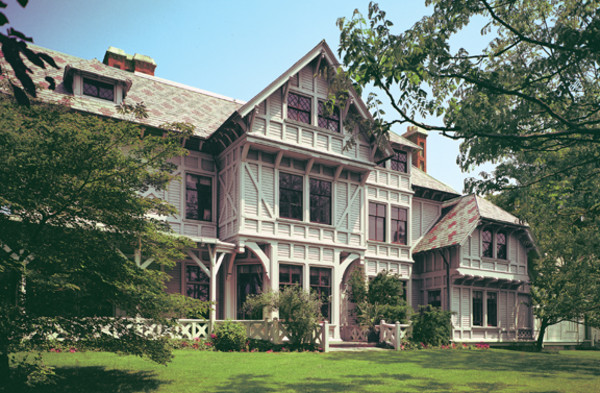
The full-blown Stick Style is easily traced back to the “Swiss cottages” and wood-trussed folk houses of 1850s American plan books, and to the picturesque style popularized so effectively by Andrew Jackson Downing during the 1840s. His cottages evoked Gothic England, to be sure—but they were all-American, a timber-framed Carpenter’s Gothic with board-and-batten walls, their porches and vergeboards (ornament at the eaves) made of wood.
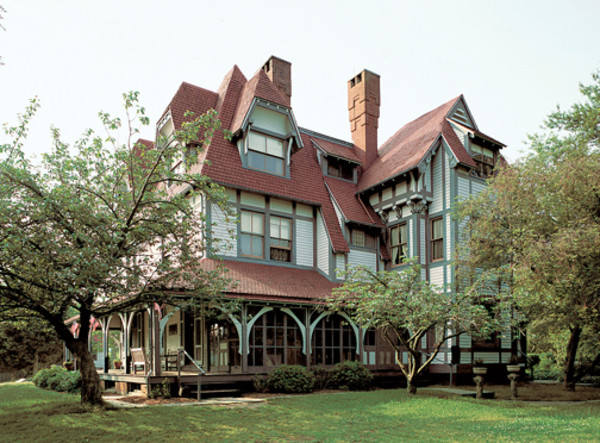
After 1862, the folk tradition became a conscious style in the hands of architects. Stick Style houses were built throughout the 1870s and 1880s. The style evolved and reached its peak in America, and nowhere else.
Later examples show the influence of the reform movements in design and architecture, particularly that of Charles Locke Eastlake, the English tastemaker and critic whose book Hints on Household Taste came to American in 1872. (He was as famous as Martha Stewart is today.) His Aesthetic designs are abstracted, flat, and angular—Gothic rather than classical but very modern, and incorporating Japanese motifs. Many Stick houses, especially in California, are commonly labeled Eastlake, including the famous Painted Ladies row houses in San Francisco.
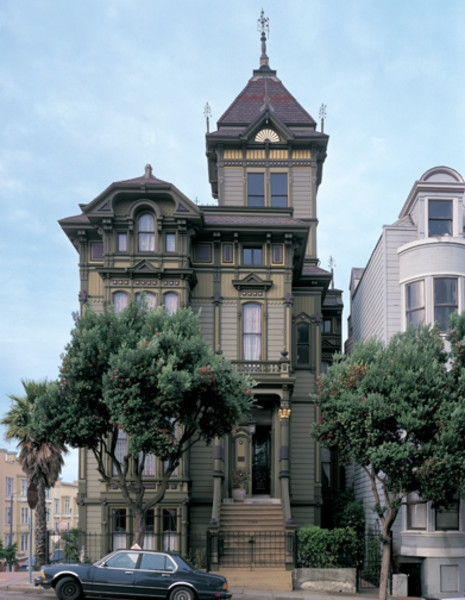
Hallmarks of the Stick Style
A defined structure and allusion to timber framing mark the Stick house. Hallmarks include a vertical emphasis through the use of boards framing windows and panelizing the facades, as well as chamfers, cutaway corners, trusses, and English medieval roof and chimney details.
• Sticks include corner posts, lintels, window frames and, most obviously, wall battens, sometimes on the diagonal as in timber framing.
• Vertical emphasis. Even when the house sprawls, wood ornament and steep roofs move skyward.
• Tudor and Gothic elements include carved brackets and spandrels, clipped gable roofs, diamond-paned sash, drop pendants, and knee-braces on porch posts.
Inside the Stick Style House
Those simple “stick cottages” that predated the architect-designed Victorian houses of the 1870s would have been relatively plain. Local “cottage furniture” (often painted and sometimes stenciled) and family pieces furnished them. Wallpaper, machine-made and affordable, was popular for living rooms and halls. Much of it, early on, was still Rococo—flowery, with cartouches and three-dimensional shading. Paper was applied from baseboard to cornice, with perhaps a narrow band of contrasting border.
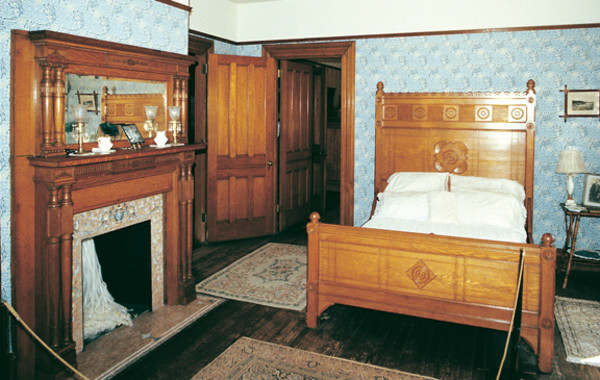
Elizabethan motifs such as quatrefoils were popular. Contrasting colors were used in public rooms, but bedrooms were cool and quiet. Softwood still predominated. Floors and woodwork were painted. Chair rails came back in style.
For the first time in our history, carpeting was generally available in this mid-19th-century period: mostly ingrain and three-ply, with Brussels, Wiltons, and tapestry carpet available to the wealthy. Strips were sewn and laid wall to wall.
Stick Style houses continued to be built according to patternbook and even mail-order plans. The designs of the Pallisers, carpenter–architects publishing between 1876 and 1908, come to mind. Eastlake took over Downing’s place as a household name after 1872, spawning the “Eastlake decades.”
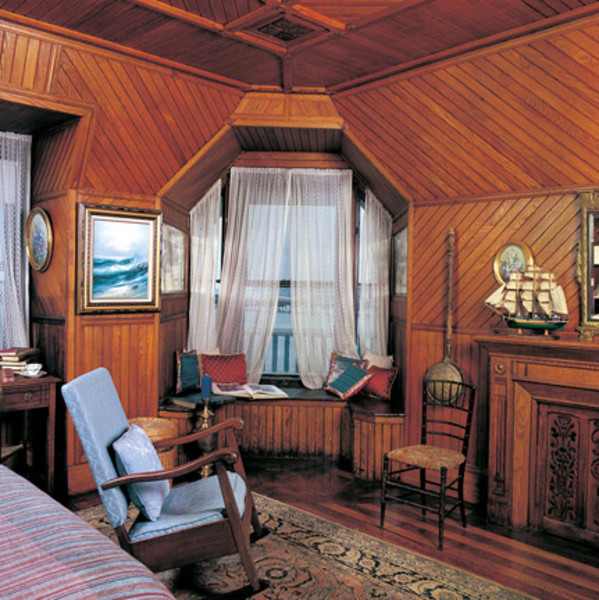
By then many more options were available in decorating and furnishing. Rococo was finally dead, and gone with it were curved lines, ornate carving, and highly polished surfaces. The reform movement gained credence in America, where the late or Reformed Gothic and the Aesthetic Movement, the English Arts & Crafts Movement, Walter Crane, and William Morris were by now familiar.
Henry Hudson Holly extolled the practical virtues of the dado in 1878, helping along the trend toward a tripartite wall treatment: dado (or wainscot), fill, and frieze. Clarence Cook, who advised a sparing use of wallpaper in a room, noted that a wainscot solved the problem.
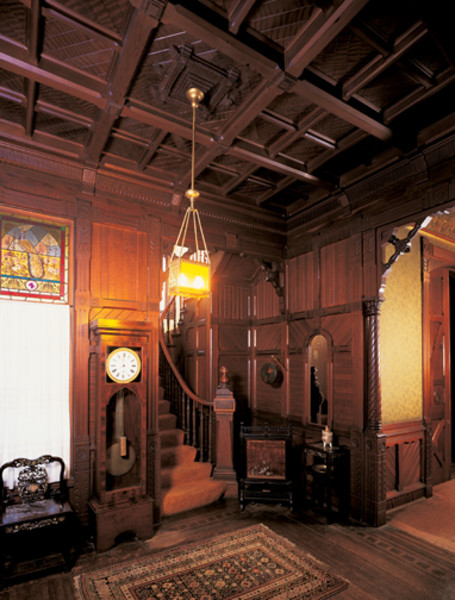
The embossed wallcovering Lincrusta–Walton (highly decorative, related to linoleum) was introduced in the 1880s, the same decade when decorated ceilings reached their height of popularity. After 1875, the Moorish and the Japanesque in decoration exerted strong influence. However exotic the originals of influence, it was from England that American decorating trends emerged.
The full-blown Stick Style, as practiced by architects including Boston’s H.H. Richardson and Philadelphia’s Frank Furness, is associated with the later period. Surviving interiors, although they are extravagant and not representative, provide clues for decorating more typical Stick houses. Note that the Mark Twain house was decorated by no less than Louis C. Tiffany and Company; it portrays the pinnacle of Aesthetic taste in America.
Recommended Reading
The Shingle Style and the Stick Style
By Vincent Scully (Gibbs Smith, 2006)
Still in print, the groundbreaking discourse by Yale architecture professor Scully that named the style in the 1950s. Not a picture book.
Creating the Artful Home: The Aesthetic Movement
By Karen Zukowski (Gibbs Smith, 2006)
In America, the Aesthetic Movement was popular in the same decades as the Shingle Style (1870-1900), and they share traits as transitional styles between Victorian excess and the more naturalistic Arts and Crafts sensibility. This book is more than a history of the movement; it provides insight into the rationale and is helpful for finding a creative approach to home-making now.
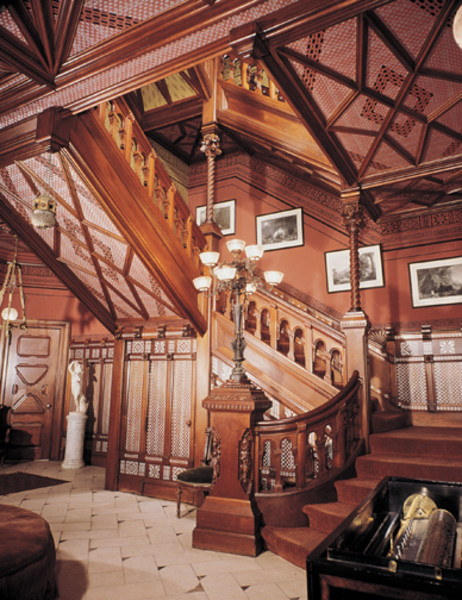
The entry stair at the Mark Twain House in Hartford, Connecticut
The Aesthetic Movement
By Lionel Lambourne (Phaidon, 1996)
The English art movement of the 1880s and 1890s that had such great impact even in America. The book is monumental but very readable, starting with the Japonisme fad and moving on to Whistler, Ruskin, Oscar Wilde, Godwin, even Mackintosh. Lavish.
America’s Painted Ladies
By Elizabeth Pomada (Studio, 1994)
A beautifully illustrated book in the Painted Ladies series, including houses of the Stick Style and era in San Francisco and elsewhere in the country.
The Painted Ladies Revisited
By Elizabeth Pomada (Studio, 1989)
This one also shows interior restorations.
Hints on Household Taste
By Charles L. Eastlake (Dover, 1986)
Reprint of the 1868–1872 book by the Aesthetic Movement tastemaker and critic.
The Queen Anne House: America’s Victorian Vernacular
By Janet Foster (Abrams, 2006)
Queen Anne, Shingle, and early Tudor Revival houses in this country all owe a debt to the English Queen Anne movement that brought back vernacular forms. With some houses, it’s hard to tell where Queen Anne ends and Shingle begins. This book showing 21 residences paints a clearer picture of the relationships among styles, and offers plenty of architectural and decorating details.
William Morris: Décor and Design
By Elizabeth Wilhide (Pavilion Books, 1997)
A focused, intelligent resource that doesn’t lose its appeal. Morris’s wallpapers and furnishings are the theme, accompanied by photos of rooms decorated by Morris & Co., and contemporary interpretations, with illustrated pattern glossaries.







